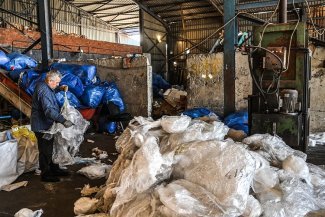Two employees work at one of the warehouses of Logifashion, a Spanish multinational logistics company that manages fashion shipments and, increasingly, the collection of returns.
Some 131 billion packages traversed the planet in 2020, the equivalent of roughly 4,000 per second, the majority of which were delivered to a residence of some kind. With the globe paralysed by the Covid-19 pandemic, shirts, shoes and electronic devices crossed oceans, highways and cities en masse to satisfy the urgent desires of consumers. And a significant number of them were sent back. This is the flip side of mass consumption: mass returns. An estimated one in three products purchased online is returned within three months of purchase. To where, most consumers don’t know.
While returning goods is a right, it has led to numbers that are increasingly out of control. In the US alone, consumers returned more than US$102 billion worth of e-commerce merchandise last year, or 18 per cent of total sales.
“We’re returning more because we’re buying more online, but also because we’ve become so spoiled. So much gets returned nowadays, especially in fashion, footwear and accessories,” Jordi Ordóñez, a consultant specialising in e-commerce, tells Equal Times.
As part of their aggressive policies aimed at attracting customers, large platforms like Amazon have made it increasingly easy, and in many cases free, for consumers to return products. It’s afterwards that things get more complex.
Every time a product is returned, it begins a long and costly journey across many kilometres and through several warehouses, even across several borders, and sometimes travels directly from the dissatisfied consumer’s home into the rubbish.
Free returns
As it turns out, shoppers don’t even like to return things. According to Francis Blasco, dean of the Faculty of Commerce at the Complutense University of Madrid and a specialist in neuromarketing: “People generally don’t like to return things. This has been very well studied. Consumers like to get it right. If someone returns something it’s because they need to.”
In fact, we don’t return as much to brick-and-mortar shops as we do online. Customers return between 20 per cent and 30 per cent of items purchased online – and up to 50 per cent for special occasions such as Christmas or Black Friday – but only between 6 and 8 per cent of items purchased in physical shops.
There’s more room for error in online shopping: products aren’t always well-described and clothing sizes don’t always fit. According to a study by the logistics company UPS, around 60 per cent of returns occur because the product arrives damaged or does not match its description. However, another significant percentage of buyers – 17 per cent – return products simply because they have changed their mind and no longer want them. This is known as the right of withdrawal. But there is a fine line between this right and abuse.
For example, some people will buy the same garment three times in different colours and sizes, only to keep one and return the rest. This practice, known as bracketing, has become commonplace, especially among young shoppers aged 21 to 29. Many buy things they already plan on returning.
“The problem is that it’s all free,” says Ordóñez. “If everything is on the house and you don’t have to pay for the return, you get used to returning packages with no consequences attached. Some people will even buy a product to take a picture of it, upload it to Instagram or TikTok and then return it.” This is a dangerous habit, as Ordóñez argues, because what they believe to be free has a very real cost.
The black mile
“Transport is responsible for 40 per cent of direct and indirect pollution in cities,” says May López, an expert in sustainable logistics. That’s why the ‘last mile’, the final journey a product makes to your doorstep, has such an environmental impact. “Even when it’s done with an electric vehicle, delivering a product to a home generates traffic, noise and pollution,” she explains.
The impact of return journeys is compounded by another problem: pickups are more difficult to bundle than deliveries. A report by the logistics company Optoro finds that returns transport generates 15 million metric tonnes of CO2 globally every year. Another study by the University of Bamberg in Germany estimates the environmental impact of returns in Germany in 2018 at 238,000 tonnes of CO2, the equivalent of 2,200 daily car trips between Hamburg and Moscow.
Returned goods are often sent to warehouses for inspection located thousands of kilometres away from their original point of departure.
Professor Sharon Cullinane of the University of Gothenburg in Sweden found that some Swedish companies outsource return processing to lower-wage countries such as Poland and Estonia, and even to Asian countries.
The returned goods’ journey continues once they have arrived in the warehouses. Products that are resold must be checked, disinfected and repackaged – as quickly as possible, especially if they are fashion items. “If you’re slow and don’t reintroduce a garment to the market for another month and a half or two months, it has very little chance of being sold,” explains Lluís Alarcón, site manager at Logifashion, a Spanish multinational logistics company that manages fashion shipments and, increasingly, the collection of returns. “The brands give us instructions to follow depending on whether they want to reintegrate the returned item into the normal sales circuit, repurpose it for second-hand sales or send it to other channels.”
Another critical factor comes into play at this stage. According to the University of Bamberg, 79 per cent of everything we return is sold as is, 13 per cent goes to second-hand markets, 2.1 per cent is recycled, 0.9 per cent is donated to charities and 3.9 per cent is destroyed. Some 20 million items a year end up in the rubbish before ever being used, around 7 million of which are in perfect condition: manufactured, packaged, transported and returned, only to be thrown away.
Buy, return, dispose
In 2019, an activist from Greenpeace Germany infiltrated Amazon’s logistics centre in Winsen, where he saw how part of the returns ended up at workstations called ‘destroy stations’.
A French programme that year reported the same practice at an Amazon site in the Saône-et-Loire department. Subsequent investigations in Canada in 2020 and the United Kingdom in 2021 also revealed that Amazon was destroying hundreds of unused products – not only returns, but also stock that was never sold.
“There’s no logic to this practice whatsoever,” says Celia Ojeda, head of consumer affairs at Greenpeace Spain. “Imagine if you went to a clothes shop and tried on a pair of trousers and when you left, the person in the shop threw them away. That would be unthinkable. But that’s exactly what’s happening with online shopping.”
The reason is that refurbishing a product can sometimes be more expensive than destroying it. “The return is free but the retailer pays for it in both lost margins as well as extra transport, inspection and storage costs. External suppliers who sell through Amazon pay for warehouse space by the month and surface area. It can sometime be more cost-effective for them to donate or destroy products rather than keep them,” says Ordóñez.
Lluís Alarcón admits that in his industry he is also asked to send garments for destruction if, for example, they have complicated stains or defects that are difficult to repair. But, as he explains, the practice “used to be more common, but now there are so many alternative second-hand channels, so many facilities for selling in other countries and continents that it has been reduced.”
The reality is that there is little transparency on this issue. Most companies do not provide information about what they do with their returns. Some countries, such as Germany and France, have laws in place to prohibit the destruction of products that are still fit for sale, while Spain and the European Commission are drafting similar legislation. But environmentalists are calling for additional steps to ensure that companies see to destroying rejected products themselves rather than sending them to third countries.
Is it possible to return less?
Viewed purely through an economic lens, it is in companies’ own interest to reduce and efficiently manage their returns. Many are already implementing proposals such as improving product information on their websites (using photos, videos and even virtual testers), extending return periods, establishing quality controls so that items do not arrive damaged, and replacing home returns with returns to lockers or physical shops.
“We’ve launched a movement called entrega sostenible (sustainable delivery),” says López. “Instead of delivering and returning products to and from your home, you choose convenience points, neighbourhood shops, and do it there. This allows us to consolidate deliveries, reduce 20 per cent of last-mile emissions and eliminates the need for a delivery person to hang around waiting for you to be home, all while supporting local commerce.”
Large platforms such as Amazon and Walmart have opted for a different approach. They have created algorithms capable of calculating the cost of each return. If the numbers don’t add up, customers still get their refunds but are left with the packages. “I think it’s unfair to put the responsibility on the consumer in this way. Making someone keep the product doesn’t solve the problem,” says Celia Ojeda of Greenpeace, as it will ultimately be the customer who disposes of the product.
Companies can, however, stop offering something for free that they themselves have so far been unable to handle. “The consumer must bear some cost,” says Blasco.
This proposal could prove unpopular – almost half of online shoppers expect returns to be free – but useful. According to the University of Bamberg, a return fee of around €2.95 imposed by law would prevent 16 per cent of returns and reduce unfair competition by large platforms against small businesses.
Paying, they argue, is a way to increase consciousness. Free returns, after all, are never free. Someone always pays: the sellers, the transport companies, and ultimately the planet.













